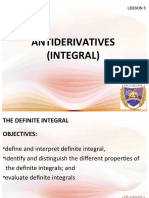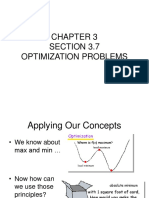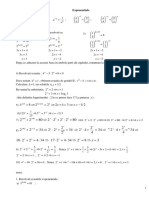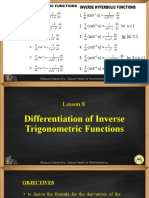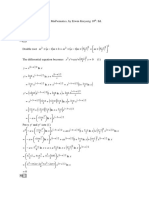s5 Further Calculus 3 - Maclaurin's Theorem-1
s5 Further Calculus 3 - Maclaurin's Theorem-1
Uploaded by
isaiahseruyangeCopyright:
Available Formats
s5 Further Calculus 3 - Maclaurin's Theorem-1
s5 Further Calculus 3 - Maclaurin's Theorem-1
Uploaded by
isaiahseruyangeOriginal Title
Copyright
Available Formats
Share this document
Did you find this document useful?
Is this content inappropriate?
Copyright:
Available Formats
s5 Further Calculus 3 - Maclaurin's Theorem-1
s5 Further Calculus 3 - Maclaurin's Theorem-1
Uploaded by
isaiahseruyangeCopyright:
Available Formats
Page 1 of 4
MACLAURIN’S THEOREM
Maclaurin’s theorem is a special form of Taylor’s series expansions.
If x is small, then
x2 x3
f x f 0 f 0 f 0 f 0 ... is the statement of Maclaurin’s theorem.
x
1! 2! 3!
Example 1
Use Maclaurin’s theorem to expand the following as far as the fourth term.
(a) ex (b) 1 5x
Solution
(a) Let f ( x) e x ; f 0 1
f x e x ; f 0 1
f x e x ; f 0 1
f x e x ; f 0 1
x2 x3
From f x f 0 f 0 f 0 f 0 ...
x
1! 2! 3!
2 3 2 3
ex 1
x
1 x 1 x 1 ... 1 x x x .
1 2 6 2 6
f x 1 5 x 1 5 x 2 ; f 0 1
1
(b) Let
f x 1 5 x 2 ; f 0 5
5 1
2 2
f x 1 5 x 2 ; f 0
25 3 25
4 4
f x 5 1 5 x 2 ; f 0
75
5 375
8 8
@KCB MATHS DEPARTMENT 2021, Prepared by HOD 0782994248
Page 2 of 4
x2 x3
From f x f 0 f 0 f 0 f 0 ...
x
1! 2! 3!
x 5 x 2 25 x 3 375 5 25 2 125 3
1 5x 1 1 x x x
12 2 4 6 8 2 8 16
Example 2
Given that 𝑦 = ln(𝑥 2 + 𝑥 + 2), find the Maclaurin’s expansion of 𝑦 up to the third term. Hence
estimate ln 2.11 truncated to 4 significant figures.
Let
y f x ln x 2 x 2 ; y (0) ln 2
2x 1
y 0
1
y ;
x x2
2
2
y
x 2
x 22 2 x 12 x 1
; y0
3
x 2
x 2
2
4
x2
From f ( x) f (0) x f (0) f 0 ...
2!
2
x 3x 2
ln x x 2 ln 2
2 8
...
By comparison, ln x 2 x 2 ln 2.11 x 2 x 0.11 0
x 0.1 or x 1.1 (discard)
0.1 30.1
2
Now ln 2.11 ln 2 0.74689718 0.7468 4S.F
2 8
Example 3
Given that y lnx 2 2 x 3 , prove that x 2 2 x 3 d
3
d2y
2x 1
y dy
(a) 2 0.
dx3 dx 2
dx
(b) Hence, use Maclaurin’s theorem to expand y lnx 2 2 x 3 as far as the term in x 3 .
(c) Use your expansion in (b) to approximate ln 3.21 correct to four decimal places.
Solution
@KCB MATHS DEPARTMENT 2021, Prepared by HOD 0782994248
Page 3 of 4
2x 2
y lnx 2 2 x 3 ,
dy
(a) 2 …. (i)
dx x 2x 3
Cross multiplying, x 2 2 x 3
dy
2x 2
dx
Now differentiating using the product rule, x 2 2 x 3
d2y
2 x 2 2 …. (ii)
dy
2
dx dx
Differentiating again, x 2 2 x 3
d3y d2y d2y
3
2 x 2 2
2 x 2 2
dy
2 0
dx dx dx dx
d3y d2y
x 2 x 3 3 2x 1 2 2
2 dy
dx
0 …… (iii)
dx dx
(b)
f x y ln x 2 2 x 3 ; f 0 ln 3
2x 2
; f 0
dy 2
From (i) 2
dx x 2x 3 3
x d
2
2 x 2 2 , 3 f 0 2 2
y dy 2
From (ii) 2
2x 3 2
dx dx 3
f 0
2
9
d
3
d2y
2x 1 0 ; 3 f 0 2 2 0
y dy 2 2
From (iii) x 2 2 x 3 2
dx3 dx 2
dx 9 3
f 0
16
27
x2 x3
From f x f 0 f 0 f 0 f 0 ...
x
1! 2! 3!
x 2 x 2 2 x 3 16
ln x 2 2 x 3 ln 3
13
2 1 2 8 3
ln 3 x x x
2 9 6 27 3 9 81
(c) By comparison, lnx 2 2 x 3 ln 3.21 ln 3 0.21
x 2 2 x 0.21 0 ; x 0.1 or x 2.1discard
Taking x 0.1 , ln 3.21 ln 3
2
0.1 1 0.12 8 0.13 1.1662913 1.1663
3 9 81
@KCB MATHS DEPARTMENT 2021, Prepared by HOD 0782994248
Page 4 of 4
Trial exercise
1. Use Maclaurin’s theorem to expand the following as far as the term in x 3 .
(i) ln 1 2 x (ii) sin x (iii) e x cos x
ln sin x cos x
1
(iv) 1 4x 2 (v) (vi)
1 2x
2. Using Maclaurin’s theorem, find the first three non zero terms of the series for
log5 1 e x .
3. Using Maclaurin’s theorem, expand y x ln 1 x as far as the term in x 3 .
2
4. By Maclaurin’s theorem, expand ln x3
1 4 x as far as the term in .
5.
Given that y lnx 2 x 2, show that x 2 x 2
d3y
dx 3
22 x 1 d2y
dx 2
dy
2 0 . Hence
dx
by Maclaurin’s theorem, expand y lnx x 2 as far as the term in x .
2 3
d2y dy
6. Given that y e 2 x sin 3 x , prove that 2
4 13 y 0 . Hence by Maclaurin’s
dx dx
theorem, expand y e 2 x sin 3 x as far as the term in x 3 . Also estimate e 6
sin correct
4
to three significant figures.
7. Use Maclaurin’s theorem to expand ln 1 2 x x 2 as far as the term in x 3 . Hence
evaluate ln 1.19 correct to four decimal places.
@KCB MATHS DEPARTMENT 2021, Prepared by HOD 0782994248
You might also like
- Differential and Integral Calculus by Feliciano and Uy PDFDocument39 pagesDifferential and Integral Calculus by Feliciano and Uy PDFRafael Alarcon60% (15)
- Coin-Op: Washer ExtractorsDocument4 pagesCoin-Op: Washer Extractorssumit11235100% (1)
- Lesson 13 Integration by Miscellaneous SubstitutionDocument12 pagesLesson 13 Integration by Miscellaneous Substitutionomay12No ratings yet
- Exponential FunctionsDocument26 pagesExponential FunctionsHanna FerNo ratings yet
- 2015b Mat271b Exa MemoDocument9 pages2015b Mat271b Exa MemoMduduzi Magiva Mahlangu100% (1)
- Examples MomentumDocument9 pagesExamples Momentumettypasewang0% (1)
- Icse Class 10 Maths LMR DoubtsDocument10 pagesIcse Class 10 Maths LMR DoubtsSANDEEP SINGHNo ratings yet
- MI PU1 H2Maths 2014 Promo I Solution (Modified)Document5 pagesMI PU1 H2Maths 2014 Promo I Solution (Modified)ShantoshCumarasurierNo ratings yet
- DIFFERENTIAL EQUATIONS QUESTSIONSDocument10 pagesDIFFERENTIAL EQUATIONS QUESTSIONSArjunjyot SinghNo ratings yet
- PDF Differential and Integral Calculus by FelicianoDocument39 pagesPDF Differential and Integral Calculus by FelicianoAlexa Lei MediodiaNo ratings yet
- REVISION EXERCISE CH 11 - 14 PRE TOP UNIVERSITAS PDFDocument6 pagesREVISION EXERCISE CH 11 - 14 PRE TOP UNIVERSITAS PDFmuhammad IzaazNo ratings yet
- Lesson 09-Differentiation of Inverse Trigonometric FunctionsDocument8 pagesLesson 09-Differentiation of Inverse Trigonometric FunctionsAXELLE NICOLE GOMEZNo ratings yet
- Linear Approximations and DifferentialDocument3 pagesLinear Approximations and DifferentialAisya IzoraNo ratings yet
- Lesson 3 Definite IntegralDocument21 pagesLesson 3 Definite Integralomay12No ratings yet
- S5 Math Calculus - DifferentiationDocument7 pagesS5 Math Calculus - DifferentiationTULIRINYA JESTUNo ratings yet
- Lesson 9 Differentiation of Inverse Trigonometric FunctionsDocument8 pagesLesson 9 Differentiation of Inverse Trigonometric FunctionsraphaelhaayoNo ratings yet
- Ial pm1 Ex9cDocument3 pagesIal pm1 Ex9cWandaNo ratings yet
- Chapter 6C_3c8cf98e-a30c-4333-a056-31dd6f0755dfDocument10 pagesChapter 6C_3c8cf98e-a30c-4333-a056-31dd6f0755dfrajesh kumarNo ratings yet
- Document From RimshaDocument12 pagesDocument From Rimshacute angleNo ratings yet
- Section 3.7 Optimization ProblemsDocument24 pagesSection 3.7 Optimization Problemsjoan_padilla2000No ratings yet
- Limits at InfinityDocument5 pagesLimits at Infinitymike capitoNo ratings yet
- MAT1581 Assignment 3 - SolutionsDocument5 pagesMAT1581 Assignment 3 - SolutionsLEANATTENo ratings yet
- The Definite Integral:) A (F) B (F X F DX) X (FDocument10 pagesThe Definite Integral:) A (F) B (F X F DX) X (FAlwin Palma jrNo ratings yet
- Application of Derivative_(Ex. 2)Document32 pagesApplication of Derivative_(Ex. 2)Tharun KumaranNo ratings yet
- Grade 11 Mathematics Paper 1 (Memo 25 Sept 2023)Document18 pagesGrade 11 Mathematics Paper 1 (Memo 25 Sept 2023)choncoazolaNo ratings yet
- Lecture 07 03-11-21Document13 pagesLecture 07 03-11-21Tayyab HusaainNo ratings yet
- Differential Calculus SolDocument6 pagesDifferential Calculus Solheettanna2006No ratings yet
- 7.2 Power Rule 6Document6 pages7.2 Power Rule 6Hin Wa LeungNo ratings yet
- Exponential eDocument2 pagesExponential ePopa EugenNo ratings yet
- Mathematics - N5 - Test - 1A MGDocument6 pagesMathematics - N5 - Test - 1A MGMpezaNo ratings yet
- Algebraic FractionsDocument8 pagesAlgebraic Fractionskanch anaNo ratings yet
- Functions & ITF (Main) SolutionDocument7 pagesFunctions & ITF (Main) Solutionshehbazthakur123No ratings yet
- Lesson 2 Evaluation of Limits of FunctionsDocument21 pagesLesson 2 Evaluation of Limits of FunctionsraphaelhaayoNo ratings yet
- Solusi Review Utbk 2019 Matematika Saintek: Paket 3Document1 pageSolusi Review Utbk 2019 Matematika Saintek: Paket 3Hana AzkiaNo ratings yet
- Solusi Review Utbk 2019 Go - Matematika Paket 3Document1 pageSolusi Review Utbk 2019 Go - Matematika Paket 3EkiBheBheNo ratings yet
- Resolución Ejercicios GTP 2PDocument37 pagesResolución Ejercicios GTP 2Pagustinargos708No ratings yet
- Chap 3 - 1 Double IntegralDocument19 pagesChap 3 - 1 Double Integraljingning2929No ratings yet
- Practice Test 02 _ Test Paper (Maths) __ 12th Board Booster 2025Document10 pagesPractice Test 02 _ Test Paper (Maths) __ 12th Board Booster 2025harshpc60No ratings yet
- 1 X X X X : Examples: Example 1: Consider The SystemDocument16 pages1 X X X X : Examples: Example 1: Consider The SystemSantiago Garrido BullónNo ratings yet
- 04.11.24 Senior Main Revision Sheet Solutions (1)Document88 pages04.11.24 Senior Main Revision Sheet Solutions (1)xariso5901No ratings yet
- Quiz 2- Indefinite Integrals IIDocument4 pagesQuiz 2- Indefinite Integrals IIhboy02649No ratings yet
- Bks MaaSL 0306 ws00 XxaannDocument3 pagesBks MaaSL 0306 ws00 XxaannAanya RalhanNo ratings yet
- Volume IntegralsDocument1 pageVolume IntegralsKarthikeyaNo ratings yet
- Lesson 9 Differentiation of Inverse Trigonometric FunctionsDocument8 pagesLesson 9 Differentiation of Inverse Trigonometric FunctionsCupackeNo ratings yet
- Exercise 3E: X X Yx X X X Yx XDocument8 pagesExercise 3E: X X Yx X X X Yx XCalixto JaxonNo ratings yet
- 7.5 Chain Rule 5Document4 pages7.5 Chain Rule 5Hin Wa LeungNo ratings yet
- DIFFERENTIATION TECHNIQUES - The Chain RuleDocument17 pagesDIFFERENTIATION TECHNIQUES - The Chain RuleElisha ManishimweNo ratings yet
- MTH122 - Part Ii - Lec2 2Document51 pagesMTH122 - Part Ii - Lec2 2k6fnrcd6ybNo ratings yet
- Exercise 4.4 (Solutions) : (Question # 1 (I)Document6 pagesExercise 4.4 (Solutions) : (Question # 1 (I)MeerNo ratings yet
- Homo Func & Partial DiffDocument43 pagesHomo Func & Partial Diffheyhowwhy67No ratings yet
- Final Quadratic Equations Lecturwise 11 to 20 Answers-solDocument14 pagesFinal Quadratic Equations Lecturwise 11 to 20 Answers-soldivyanshxixNo ratings yet
- Gauteng Prelims Paper 1 2017 MEMODocument14 pagesGauteng Prelims Paper 1 2017 MEMOmmabathovilakazi304No ratings yet
- Lesson 2 Evaluation of Limits of FunctionsDocument21 pagesLesson 2 Evaluation of Limits of FunctionsCupackeNo ratings yet
- Lesson 8-Differentiation of Inverse Trigonometric FunctionsDocument10 pagesLesson 8-Differentiation of Inverse Trigonometric FunctionsLuis BathanNo ratings yet
- Problem Set 2.5: Advanced Engineering Mathematics, by Erwin Kreyszig 10 - EdDocument12 pagesProblem Set 2.5: Advanced Engineering Mathematics, by Erwin Kreyszig 10 - Edzxcv25824066No ratings yet
- 1000 Problems in Uace Mathematics e -VersionDocument126 pages1000 Problems in Uace Mathematics e -VersiondonjazzyokelloNo ratings yet
- Answers Precal2 Quiz1Document2 pagesAnswers Precal2 Quiz1teachopensourceNo ratings yet
- 2022 Grade 12 Math Trial Exam Paper 1 GP MemoDocument23 pages2022 Grade 12 Math Trial Exam Paper 1 GP MemocharlenemoyNo ratings yet
- 19 SYGqd XF900 G MB 9 JD8 Wjmua Dki CN C2 VCDocument12 pages19 SYGqd XF900 G MB 9 JD8 Wjmua Dki CN C2 VCmdikwamihlaliiNo ratings yet
- 2022 H2 C8A Integration Techniques - TutorialDocument5 pages2022 H2 C8A Integration Techniques - TutorialKyan 2005No ratings yet
- Factoring and Algebra - A Selection of Classic Mathematical Articles Containing Examples and Exercises on the Subject of Algebra (Mathematics Series)From EverandFactoring and Algebra - A Selection of Classic Mathematical Articles Containing Examples and Exercises on the Subject of Algebra (Mathematics Series)No ratings yet
- DTC-SVM Scheme For Induction Motors Fed With A Three-Level InverterDocument5 pagesDTC-SVM Scheme For Induction Motors Fed With A Three-Level Inverterdam_dar666No ratings yet
- Northern Coalfields Limited 1 PDFDocument6 pagesNorthern Coalfields Limited 1 PDFSuchitkumar GuptaNo ratings yet
- Tutorial LightDocument3 pagesTutorial LightNorKamilahMakhtarNo ratings yet
- Further Problems On Fluid StaticsDocument2 pagesFurther Problems On Fluid StaticsCool DouglasNo ratings yet
- Liquid Diffusion CoefficientDocument7 pagesLiquid Diffusion CoefficientFoo He Xuan75% (4)
- Chapter 21Document49 pagesChapter 21serhatserhatcangirNo ratings yet
- Tutorial 1Document3 pagesTutorial 1Ashish KatochNo ratings yet
- The Future of Humanity ProjectDocument8 pagesThe Future of Humanity Projectapi-563597519No ratings yet
- Assignment 1 EdDocument4 pagesAssignment 1 EdMohamad HasyimiNo ratings yet
- DynaFlexOscillator enDocument6 pagesDynaFlexOscillator enminhtrieu999No ratings yet
- Movitec B (50Hz) PDFDocument62 pagesMovitec B (50Hz) PDFTurbo Snail RNo ratings yet
- ProceedingDocument7 pagesProceedingnoor hafizzatul izzahNo ratings yet
- Nagesh KulkarniferrocementDocument9 pagesNagesh KulkarniferrocementFreddie KooNo ratings yet
- Special Probability Distributions: Presented By: Juanito S. ChanDocument37 pagesSpecial Probability Distributions: Presented By: Juanito S. ChanGelli AgustinNo ratings yet
- If The Distance Between Two Charges Is DoubledDocument6 pagesIf The Distance Between Two Charges Is DoubledFatehNo ratings yet
- W. F. Chen, Plasticity For Structural Engineers, 1988-153Document1 pageW. F. Chen, Plasticity For Structural Engineers, 1988-153ahmedNo ratings yet
- Series 2000 Specification SheetDocument2 pagesSeries 2000 Specification SheetWattsNo ratings yet
- Creative Thinking. Claude Shannon at Bell Lab. March 20 1952Document4 pagesCreative Thinking. Claude Shannon at Bell Lab. March 20 1952luidgi12345No ratings yet
- Stationary Waves QuestionsDocument16 pagesStationary Waves QuestionssingamroopaNo ratings yet
- Ijleo D 19 04677Document19 pagesIjleo D 19 04677sam moufNo ratings yet
- ME 205 - Statics Course Syllabus: Fall 2015Document4 pagesME 205 - Statics Course Syllabus: Fall 2015Dhenil ManubatNo ratings yet
- Parallam PSL: High Strength For Long SpansDocument2 pagesParallam PSL: High Strength For Long Spansxja1mexNo ratings yet
- Assignment 2 - Engineering Statistics PDFDocument5 pagesAssignment 2 - Engineering Statistics PDFNamra FatimaNo ratings yet
- DefinitionDocument5 pagesDefinitionAshis karmakar100% (1)
- 01 GeoModeller v33 BrochureDocument1 page01 GeoModeller v33 BrochureAlbab OnyonNo ratings yet
- SpaceLogic™ RP Controller - Room Sensor Modules - SXWREISBLE10001Document2 pagesSpaceLogic™ RP Controller - Room Sensor Modules - SXWREISBLE10001Abdelmoneim OmarNo ratings yet
- Digital Image Processing LectureDocument63 pagesDigital Image Processing LectureShabeeb Ali OruvangaraNo ratings yet
- Protection Relay Tester: Model No. JBC-702Document3 pagesProtection Relay Tester: Model No. JBC-702pemanr1914No ratings yet













